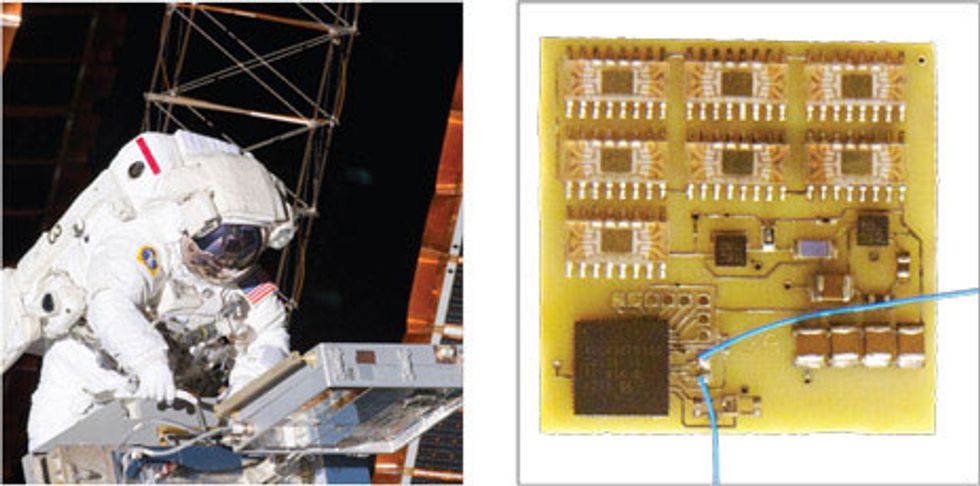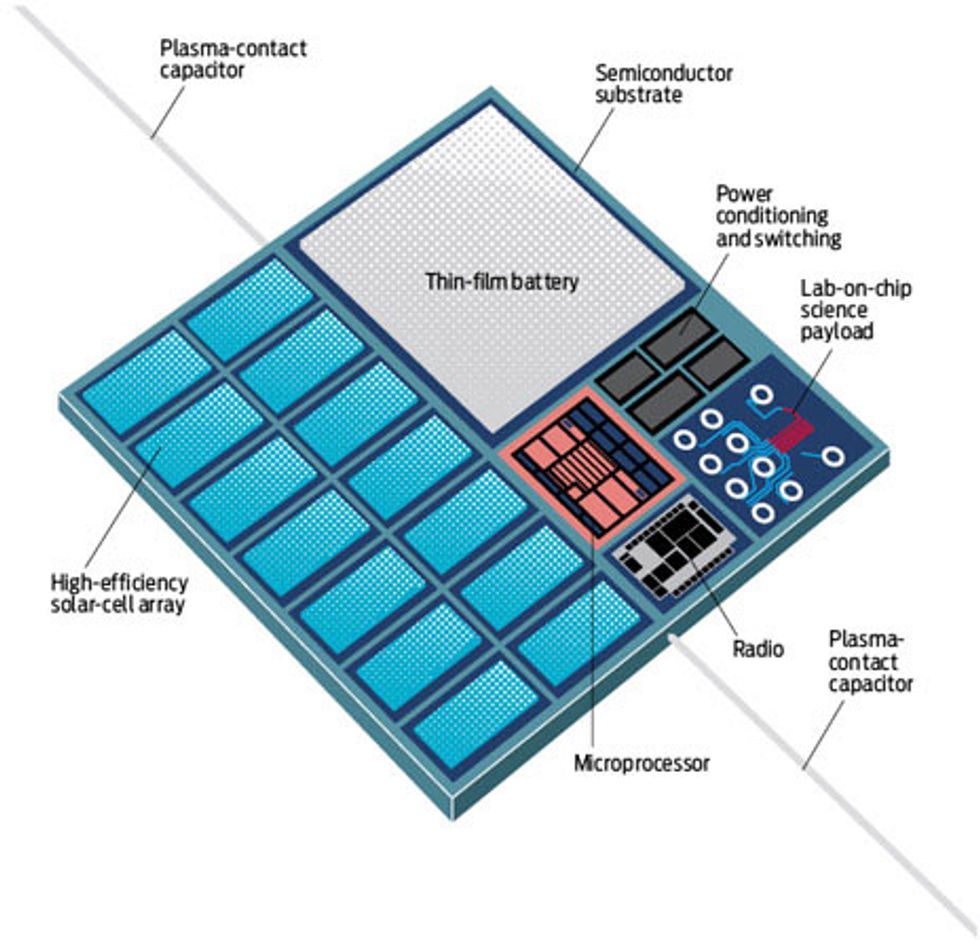Exploring Space with Chip-sized Satellites
The future of space exploration will include swarms of tiny spacecraft


Gravity may be woven into the very fabric of space-time, but some objects seem nearly immune to its pull.
Scale something down to the size of a dust particle and you'll find it can stay aloft almost indefinitely, dancing in midair on thermal currents. With matter that size, the force of air striking the surface of the particle outmatches gravity's effect on its tiny mass.
This behavior is more than just a curiosity: It could have profound implications for space exploration. Spacecraft have been getting bigger and bigger for decades, ballooning in size to carry ever more impressive equipment, from the Herschel Space Observatory's 3.5-meter telescope to the Cassini probe's 11-meter magnetometer boom. But if we can reverse that trend and instead build the tiniest spacecraft possible, we can create entirely new ways to study the solar system and beyond.
Miniaturization will inevitably mean limitation—less power, fewer instruments, and reduced ability to store and broadcast data. But dust-mote-size spacecraft could do things that no current space probe can do: coast without a parachute onto the plains of Mars or float for weeks in the soupy atmosphere of Titan. They could be mass-produced and launched by the thousands to form vast space-based networks of sensors. And if the probes could be made thin and lightweight enough, alternative forms of propulsion could eventually send them to distant worlds, without the need for rocket fuel.
In the fall of 2005 at Cornell University, graduate student Justin Atchison and I set out to create such miniature spacecraft. The aim of our project, called Sprite, is to fit everything a satellite might need on a 1-square-centimeter integrated circuit. The project finally took its first step into space on 16 May of this year, when the space shuttle Endeavour, on its final mission, carried three of our prototypes to the International Space Station. We'll find out in a couple of years how these first chips withstood the rigors of space. If all goes well, we then plan to launch smaller Sprites into orbit on their own, where they can be used to test new forms of propulsion that could ultimately take them to other planets.
Sprite is the first spacecraft-on-a-chip project to launch a prototype, but ours isn't the only group exploring the potential of miniature spacecraft. The idea goes back at least 15 years, and it has its origins in "smart dust"—tiny microelectromechanical sensor systems that can be used to measure light and temperature, register movement and location, and detect chemical and biological substances. The notion of sending such systems into space was slow to gain momentum. But it began to take off once space researchers realized that integrated circuits had become quite inexpensive, dense, and easy to fabricate, and that almost everything a spacecraft needs can now be made with semiconductors alone: solar cells for power, capacitors for energy storage, and all the memory and processing capability you could want. As with smart dust, a diversity of payloads can be fabricated to ride on a chip, including basic spectrometers, load sensors to measure particle impacts, chemical sensors, and simple CMOS cameras. Researchers around the world, including groups at Surrey Space Centre, the University of Strathclyde, the Aerospace Corp., and the Jet Propulsion Laboratory, have explored the possibility of making chip-based spacecraft and are investigating their capabilities.
Our Sprite prototypes weigh about 10 grams, but their successors will ultimately weigh between 5 and 50 milligrams and will likely be able to carry just one simple sensor each. At that size, a single Sprite will never be able to rival the data-gathering capability of such precision instruments as the Hubble Space Telescope. But we envision launching these tiny, easy-to-fabricate chips en masse to form something new: distributed sensor networks.
We could, for instance, send tens of thousands of Sprites into orbits between Earth and the sun. These simple chips would have one task: to send a signal to Earth when the local magnetic field or the number of charged particles that hit the spacecraft exceeded some threshold. Taken alone, each chip would provide just one data point. But a network of these scattered chips could produce 3-D snapshots of space weather, something no traditional spacecraft, no matter how sophisticated, could ever do on its own. A payload of a million of the relatively heavy 50-mg version of the Sprite would amount to just 50 kilograms, about the mass of a single science instrument on one of NASA's larger interplanetary spacecraft. So the launch costs of a Sprite network would be significantly lower than that of a traditional satellite.
Launching a million Sprites would be pointless unless a substantial number of them could survive the many hazards of space, including charged particles, micrometeorites, and extreme temperature swings. Their hardiness is one of the things we hope to gauge in our current experiment aboard the space station.
The Sprite prototypes have been mounted on the exterior of the ISS on a materials-science pallet called MISSE-8, which stands for Materials on International Space Station Experiment 8. Fabricated by hand in the lab, each prototype measures 3.8 cm on a side and contains seven tiny solar cells, a microprocessor with a built-in radio, an antenna, an amplifier, and switching circuitry to turn on the microprocessor whenever there's enough stored energy to create a single radio-frequency emission—a digital "beep." We'll use the timing of the Sprites' beeps to tell us the sun's angle of incidence on the chip. The more oblique the angle, the longer it will take for the chip's capacitor to charge. Measuring the time between beeps will give a rough measure of the chip's orientation to the sun.
Beyond just telling us how well the Sprite components survive in space, the experiment will reveal whether the 902-megahertz radio pulses that the chips emit can be detected on the ground. The transmitters on the prototypes must operate on very little power: The capacitors store just 1 microjoule of energy, enough to power a 100-watt lightbulb for about 10 nanoseconds. As a result, the signals are weak, only 7 percent as strong as the buzz of background noise coming from the sun and man-made sources.
To pick up this subtle signal, we need a way to make it unique and easy to extract. The best technique for the job is a technology called code-division multiple access (CDMA), more commonly used in GPS and cellphone signal processing. With CDMA, every bit of data that a given Sprite transmits is converted into a sequence of shifts in the timing, or phase, of the radio signal. These "m-sequences" will make it easier to pull the signal out from noise. They will also allow listeners on the ground to differentiate one Sprite from another, because the patterns are as unique as fingerprints, and each chip gets just one. CDMA will thus allow many Sprites to share the same carrier frequency and transmit signals to the same ground receiver, just as it lets hundreds or even thousands of cellphone users place calls at the same time.
Expanding each bit into an m-sequence should make up for the Sprites' power limitations. That's because the longer the sequence, the more powerful it will be: The signal strength is effectively integrated over time. We calculated that signals coming from the space station should be fairly easy to detect if each bit is split up into a sequence of 512 phase shifts. Such sequences take a few milliseconds to send. Sprites that are farther from Earth will need to use longer sequences to transmit each bit. A Sprite in orbit around Jupiter, for example, will likely need a full day to send a signal that can be picked up on Earth. But the chip would be able to do that with a transmitter that draws only a few milliwatts of power. With thousands of Sprites in orbit, kilobits of data can be sent each day, but it would take many millions to rival the transmission rate of conventional spacecraft. NASA's Cassini orbiter, in orbit around Saturn, can send as much as 165 kilobits of data back to Earth each second.
Because of their power limitations, it will be difficult to create Sprites that can communicate with one another fast enough for them to operate as a collaborative swarm. But the spacecraft could still stay close together as they travel through the solar system by taking advantage of what's known as the Interplanetary Transport Network. The network consists of pathways that wind through space according to the gravitational potentials of the planets. For a cluster of Sprites, the pathways would act like ocean currents, binding them together and sweeping them along as if they were a colony of plankton.
Sprites would have other ways of getting around. Although carrying onboard propellant is impractical, the Sprites' diminutive size will make them ideal for harnessing the sun's radiation pressure. Photons carry momentum, and when they strike a surface, they transfer that momentum as force. This force blows dust particles out of the solar system and has also been used to adjust the trajectories of interplanetary probes, including NASA's Messenger spacecraft, which entered orbit around Mercury in March.
The basic physics that would propel a Sprite is the same as for cosmic dust. Sprite propulsion relies on the fact the surface area of an object does not shrink as fast as its volume. Halving the radius of a uniform ball, for example, will reduce its volume by a factor of 8, but it will drop the surface area by only a factor of 4. As an object shrinks in size, this property of geometry favors forces that operate on the surface, such as aerodynamic drag, allowing it to more easily overcome the object's inertia.
With a big enough ratio of surface area to volume, a spacecraft could be propelled just by solar radiation pressure. That's the basic idea behind a solar sail, a spacecraft that employs large, thin sails to boost its surface area to catch as much sunlight as possible.
For decades, solar sails were little more than notions, but in the last few years, both NASA and Japan's space agency, JAXA, have successfully demonstrated the technology. The large sails remain folded during launch and are unfurled in space. Solar sails are difficult to deploy and are often quite delicate. Japan's IKAROS spacecraft, which launched in 2010, used a 14-meter-wide polymer sail that was just 0.0075 millimeter thick.
If a Sprite could be made thin enough, then its entire body could act as a solar sail. We calculate that at a thickness of about 20 micrometers—which is feasible with existing fabrication techniques—a 7.5-mg Sprite would have the right ratio of surface area to volume to accelerate at about 0.06 mm/s2, maybe 10 times as fast as IKAROS. That should be enough for some interplanetary missions. If Sprites could be printed on even thinner material, they could accelerate to speeds that might even take them out of the solar system and on toward distant stars.
The low mass of Sprites should also allow them to harness the magnetic fields that surround planets and pervade the solar system. In this case, they'd be taking advantage of the Lorentz force, which bends the paths of charged particles that move in the presence of a magnetic field. Like radiation pressure, the Lorentz force dominates the dynamics of very small bodies. The effect is evident in pictures of the rings of Saturn, where sunlight and plasma have ionized dust particles. Saturn's magnetic fields tug on these electrically charged particles, pulling them into streams or "spokes" that cut across the planet's rings.
A Sprite would need an electric charge to take advantage of this property of electromagnetism. In Earth orbit, charging a Sprite could be as simple as establishing a potential, via a power supply, between two wires that extend from the chip; the plasma in Earth's ionosphere would do the rest. Lightweight free electrons would quickly neutralize the Sprite's positive wire, but the heavier and slower positively charged ions wouldn't be able to discharge the negative wire as quickly, leaving the spacecraft with a net negative charge. This charge would be maintained as long as the Sprite continued to power the wires.
At Cornell, we have begun testing this charging process by exposing Sprite-size spheres to a stream of xenon plasma. The setup mimics conditions in Earth's ionosphere, and our early results suggest that the charging technique will work. If it can be accomplished in Earth's orbit, Lorentz propulsion could allow Sprites to rendezvous with other satellites without releasing exhaust plumes that could damage delicate equipment. Charged Sprites would also be able to change their orbital inclination, enabling the chips to enter an equatorial or polar orbit regardless of their original launch location. Sprites could also raise their orbits, to counteract the tug of Earth's atmosphere, and they might even escape Earth's gravity entirely if the charge is high enough.
A more spectacular application of Lorentz propulsion could turn Jupiter into a particle accelerator. Jupiter's magnetic field is 20 000 times as powerful as Earth's, and so a charged Sprite could use this magnetic field to accelerate itself in orbit around the planet. Once it reached speeds of a few hundred or thousand kilometers per second, the chip would turn off its supply of power to the wires. Jupiter's magnetic fields would then no longer confine the spacecraft, and it would be flung out of its orbit and indeed out of the solar system.
Sprites may be able to accelerate fast enough to reach the nearest star system, Alpha Centauri, in a few hundred years. That might not seem impressive; the speedup process itself could take decades, and the Sprites would arrive beyond any of our lifetimes. But consider the alternative: Solar sails, which have long been considered for interstellar trips, would take at least a thousand years—and probably a lot longer—to make such a journey.
Interstellar exploration may be a long way off, but the idea of miniaturizing spacecraft isn't speculative. Even as the largest spacecraft have been getting bigger, there has also been substantial interest and investment in smaller spacecraft. One of the most compact designs now in use is the CubeSat, an open-architecture, grapefruit-size spacecraft weighing no more than a kilogram. Dozens of CubeSat-based university research projects have now been launched into space.
The main advantage of a CubeSat is that it's cheap to build and launch. And because multiple CubeSats can fit on the same rocket, the launch costs can be shared. This strategy has reduced the price tag of sending a payload into space to about US $100 000, a fraction of the cost of sending a traditional telecommunications satellite, weighing hundreds of kilograms, into orbit. Sprites will continue this trend, allowing tens of thousands of spacecraft to be launched for the price of a single CubeSat.
But spacecraft-on-a-chip projects have very different aims from those of CubeSat and other such efforts. Our main goals are to exploit the physics of small objects and the power of mass production. In that sense, Sprite represents a paradigm shift. Rather than hand building one-of-a-kind spacecraft, we envision constructing spacecraft on wafers in much the same way that common integrated circuits are made today. During fabrication, solar cells and other components would be incorporated with microelectromechanical systems techniques. Instead of exhaustively testing each part, as is done with current spacecraft, engineers will be able to monitor Sprite quality in a less labor-intensive fashion by using statistical process control, testing a few chips from each batch to make sure they meet specifications.
Of course, chip-scale spacecraft would have some downsides. Like larger satellites, out-of-commission Sprites would contribute to the growing collection of space junk until atmospheric drag brought them back to Earth. Fortunately, Sprites in low-Earth orbit should reenter within a few days. To make missions last longer, magnetic torque coils could help orient chips so that they fly edge-on around the planet. When a Sprite reached the end of its mission, this attitude control system would turn off and the chip would turn to orbit face-on, boosting the drag it experiences. Without a parachute, a 50-mg Sprite would burn up on reentry, but Sprites weighing closer to 5 mg could flutter back down to Earth intact.
Sprites will also be far more vulnerable to damage than present-day spacecraft. Because they are lightweight and have solar cells built directly on the chip, Sprites can't be equipped with radiation shielding to protect their electronics. This lack of shielding also makes the chip more vulnerable to impacts with micrometeorites, which zip at high speed throughout the solar system. Sprites could compensate for these hazards through sheer numbers; missions could be designed so that a significant fraction of the chips could be lost without dooming the operation.
That's a fundamentally different way to explore space. Right now, we invest hundred of millions and sometimes billions of dollars in one-off satellites that are meticulously designed to survive a range of contingencies. But if we allow some failure here and there, we will open up intriguing new possibilities for investigating the universe.
This article originally appeared in print as "Chips in Space."
About the Author
Mason Peck is no stranger to unorthodox spacecraft designs. A professor of mechanical and aerospace engineering at Cornell University, he's studied magnetic docking mechanisms and tractor beams. He thinks that mass-produced spacecraft, each made of a single microchip, could be truly revolutionary. "They may be the way we'll finally democratize space exploration," Peck says.

